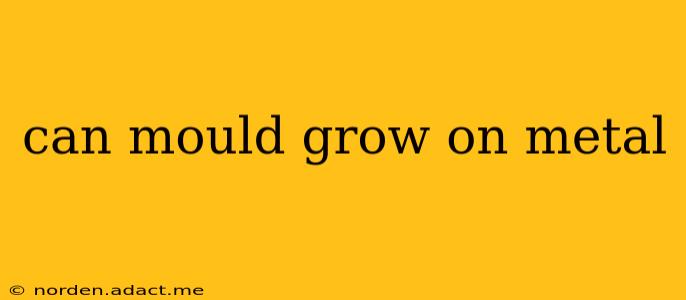Can Mold Grow on Metal? Understanding the Relationship Between Mold and Metal Surfaces
The short answer is: yes, mold can grow on metal, but not directly on the metal itself in the same way it grows on organic materials like wood or drywall. The growth is usually indirect, facilitated by other factors. This nuanced relationship is crucial to understand when tackling mold issues in your home or workplace.
This article will delve into the specifics, addressing common questions surrounding mold growth on metal surfaces.
What Conditions Allow Mold to Grow on Metal?
Mold requires moisture, a food source, and the right temperature to thrive. While metal itself doesn't provide a food source, it can support mold growth indirectly. Here's how:
-
Moisture Accumulation: Metal surfaces, particularly those in damp environments, can become condensation points. This moisture provides the perfect breeding ground for mold spores that land on nearby organic materials. Think of a leaky pipe behind a metal wall; the mold will likely grow on the drywall or insulation, not the metal directly, but the metal’s presence doesn't prevent the problem.
-
Organic Matter Build-up: Dust, dirt, debris, or even food residue can accumulate on metal surfaces. These organic materials act as the perfect food source for mold, enabling it to flourish even though the metal itself is non-nutritive. A rusty metal surface, for instance, provides a perfect habitat due to the porous nature of rust and its organic components.
-
Lack of Proper Ventilation: Poor ventilation can trap moisture near metal surfaces, creating a humid microclimate conducive to mold growth on nearby materials. This is common in poorly ventilated bathrooms or kitchens with metal fixtures.
Can Mold Grow Directly on Stainless Steel?
Stainless steel is often touted as a more resistant material to mold compared to other metals. Its non-porous nature makes it less likely to absorb moisture and provide a suitable habitat for mold spores. However, even stainless steel can support indirect mold growth if the conditions mentioned above are present (moisture, organic matter, and the right temperature). Cleaning and regular maintenance are still crucial to prevent the accumulation of debris which could support mold.
What Types of Metal are Most Susceptible to Indirect Mold Growth?
Metals that are more porous or prone to rusting are more likely to indirectly support mold growth. This is because rust provides a more hospitable surface for mold due to its porous structure and presence of organic components. Iron, steel (especially uncoated steel), and some types of aluminum are more susceptible in this regard than stainless steel.
How to Prevent Mold Growth Near Metal Surfaces
Preventing mold growth near metal surfaces requires proactive maintenance and attention to environmental conditions:
- Address Moisture Issues: Repair leaks immediately, ensure proper ventilation, and use dehumidifiers in damp areas.
- Regular Cleaning: Clean metal surfaces regularly to remove dust, debris, and organic matter. Use appropriate cleaning agents and avoid harsh chemicals that could damage the surface.
- Proper Insulation: Ensure proper insulation in areas with metal surfaces to prevent condensation.
- Regular Inspection: Inspect metal surfaces and surrounding areas regularly for signs of mold or moisture.
By understanding the relationship between mold and metal, and by taking preventive measures, you can significantly reduce the risk of mold growth in your home or workplace. Remember that even with metal surfaces, proactive maintenance is key to preventing mold problems.
